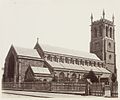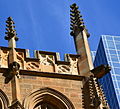| St Philip's Church | |
|---|---|
 | |
Location in Greater Sydney | |
| Location | 3 York Street, Sydney CBD, New South Wales |
| Country | Australia |
| Denomination | Anglican Church of Australia |
| Churchmanship | Low Church |
| Website | churchhillanglican |
| History | |
| Status | Church |
| Dedication | Philip the Apostle in honour of Captain Arthur Phillip, RN |
| Associated people | Notable former clergy:
|
| Architecture | |
| Functional status | Active |
| Architect(s) | Edmund Blacket |
| Architectural type | Victorian Academic Gothic with English Perpendicular detail |
| Years built | 1848-1858 |
| Specifications | |
| Materials | Sandstone, slate roofing, timber flooring, trusses and stairs, ceramic tiles |
| Administration | |
| Diocese | Sydney |
| Clergy | |
| Rector | Justin Moffatt |
| Assistant | Rt. Rev. Robert Forsyth |
| Official name | St Philip's Church of England Including Interior and Grounds |
| Type | Local government heritage (built) |
| Criteria | a., c., d., f., g. |
| Delisted | 14 December 2012 |
| Reference no. | I1972 |
| Category | Church |
| Type | Religion |
| Builder | Unknown |
St Philip's Church, Sydney, is the oldest Anglican church parish in Australia. The church is located in the Sydney city centre between York Street, Clarence and Jamison Streets on a location known as Church Hill. It is one of two churches in the Anglican Parish of Church Hill (the other being Holy Trinity, Miller's Point). Together, they are known as Church Hill Anglican. St Philip's is part of the Diocese of Sydney, Australia. [1] The church is listed on the (now defunct) Register of the National Estate. [2]







